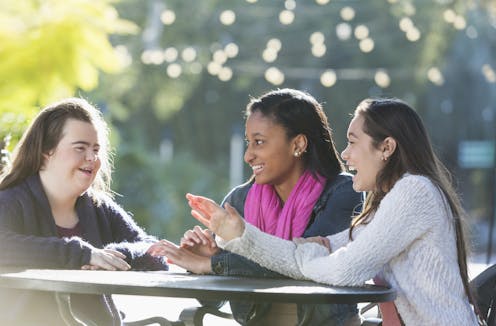
The Royal Commission into Violence, Abuse, Neglect and Exploitation of People with Disability is moving into its final phase and will report its findings in September.
For the last four years the commission and the media has reported a disturbing stream of violence and harm in the community and disability services. Less media attention has been paid to the commission’s work to find solutions.
Our research for the commission focuses on what we can do to change attitudes towards people with disability so that we are all included in our communities. This form of social change will improve the lives of the one in five Australians who identify as disabled. And achieving this kind of inclusion will also create a more diverse and interesting community.
When we value and respect people with disability, they are less likely to be subjected to harm.
5 ways to change attitudes
How we treat each other depends on how we think about ourselves and other people, our ideology and beliefs. The things we believe about other people influence how willing we are to act. People may find violence and abuse against people with disability repugnant. But they may also look away, and treat this as a problem in systems rather than a crisis for citizens.
Changing attitudes means looking deeper into our beliefs and actions, and how they can either set up the conditions where it is more likely for people to be harmed, or to be safer and better included. Improving inclusion means we need to remove the biases and discrimination in our attitudes, and across the ways that we think, believe and act.
In our research we listened to people working in advocacy, community organisations, business, government and academia. They were people with and without disability. They told us about five ways community attitudes can be changed to improve inclusion.
Here are five goals for inclusion with examples of them in action.
1) People with disability are active in all spheres of everyday life
This encourages diversity and contact in schools, work and our local communities. We need contact with people with disability and information about what they want. The Council for Intellectual Disability’s Our Health Counts campaign is an example. It has harnessed widespread support to improve the health of people with intellectual disability through improving GP practice, training in universities and raising public awareness of health disparity.
2) People with disability lead change
Changing attitudes works when leaders in the community are people with disability, and when governments and other community leaders value the diverse contributions of people with disability. One vital step is work training for young people with disability, such as the Road to Employment initiative, run by social enterprise Purple Orange.
Another example is the appointment of people with disability to leadership roles in the National Disability Insurance Agency, such as Kurt Fearnley and Maryanne Diamond.
Read more: A disabled NDIA chair is a great first move in the NDIS reset. Here's what should happen next
3) Multiple types and levels of policy and action are targeted together
These can range from walkability checklists and transport strategies in local government environmental guidelines (to identify accessibility issues) to policies and laws to require and enforce inclusion, like the Disability Inclusion and Action Plans and the Australian Disability Discrimination Act. Working at various levels at once means everyone expects inclusive attitudes.
4) Actions are sustainable
Changes that are long-term need enough resources to make a difference to the way organisations, government and business work. Inclusive education – which “values and supports the full participation of all children together within mainstream educational settings” – is an example of a resourced, long-term policy that has fundamental community-wide impact on attitudes and behaviour.
It not only affects the attitudes of students, teachers and families in schools today, but also affects the attitudes and behaviour of students with and without disability throughout their lifetimes.
5) Measuring, monitoring and research are prioritised
Keeping track of change can support organisations to make decisions about the action they take and ensure they are accountable for what they say they will do. This is one goal of the Australian Disability Strategy outcomes framework and local government disability action plans.
What’s next?
You can make sure the things you do in your work and play welcome people with disability.
What the government can do is encourage and enforce changes to attitudes and behaviour to improve inclusion of people with disability. Attitudes, behaviours and outcomes should be measured. This will help us to know what works to make change and what does not.
Later this year, the disability royal commission will report its findings and propose solutions. Then it will be up to everyone to make sure change happens.
Sally Robinson receives funding from the Australian Research Council. This research was funded by the Disability Royal Commission.
Christy Newman receives funding from the Australian Research Council, the National Health and Medical Research Council, and state and federal Australian government departments of health. This research was funded by the Disability Royal Commission.
Jan Idle is employed through a grant from the Australian Research Council. This research was funded by the Disability Royal Commission
Karen R Fisher receives funding from the Australia Research Council. This research was funded by the Disability Royal Commission
Gianfranco Giuntoli does not work for, consult, own shares in or receive funding from any company or organisation that would benefit from this article, and has disclosed no relevant affiliations beyond their academic appointment.
This article was originally published on The Conversation. Read the original article.







